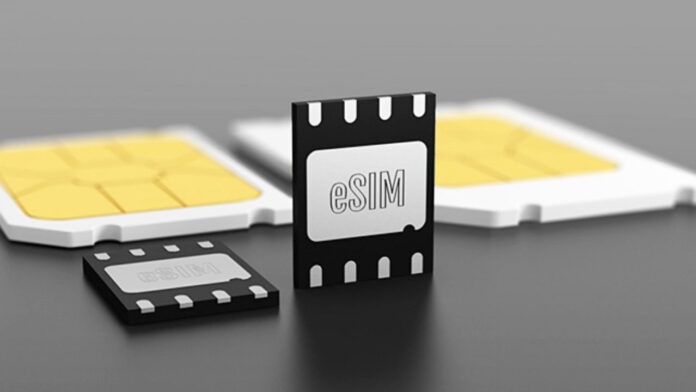Advancing Nigeria Telecoms’ Network With Esim
TECH DIGEST – The recent approval granted MTN and 9mobile by the Nigerian Communications Commission to carry out a one year trial test of eSIM on their networks, will advance the country’s telecoms network in line with global best practices, writes Emma Okonji
The latest regulatory move by the Nigerian Communications Commission (NCC) in granting MTN and 9mobile, a one-year trial test of the embedded Subscriber Identification Modules (eSIM) on their networks, has been described as a further development in advancing the country’s telecoms network, as part of preparation for achieving the digital transformation goals of Nigeria.
Shortly before the approval was granted, NCC had also approved a three-month trial of national roaming service for MTN and 9mobile, that will enable the two mobile network operators (MNOs) to carry out trial on national roaming service for a period of three months, which commenced from August 1, 2020 and ended October 31, 2020.
Industry stakeholders see the latest development on eSIM as a step forward taken by NCC in putting the nation’s digital ecosystem on the map of countries deploying cutting-edge technologies that are in line with emerging technologies such as Internet of Things (IoT), Artificial Intelligence (AI), 5G deployment, among others.
eSIM approval
The trial, approved to run for a period of one year, will involve testing 5, 000 e-SIMs by the two networks, subject to compliance with a number of regulatory conditions.
The conditions include full compliance by the MNOs with the registration of Telecoms Subscribers Regulations 2011; the Mobile Number Portability Regulations and Business Rules 2015; Guidelines on SIM Replacement 2017; and non-degradation of the Quality of Service (QoS) experience by users of e-SIMs.
The Executive Vice Chairman of NCC, Prof. Umar Garba Danbatta, said: “The primary objective of the e-SIM trial is to assess the technical performance of the e-SIM on telecoms service providers’ network towards eventual rollout, if satisfactory.”
An eSIM is a small chip that is embedded on a mobile phone or smart devices. It is designed for convenience, flexibility and simplicity. The e-SIM makes it easier for subscribers to choose a pre-paid plan provider and switch between network operators.
The information on the e-SIM is rewritable by operators and the identification information can be updated over time.
“The eSIM is a technology that will eliminate the need for physical SIM card slots on mobile devices in the near future, and the trial is in line with the commission’s forward-looking regulatory approach to ensure Nigeria’s telecoms ecosystem is in tandem with global best practices,” Danbatta said.
eSIM as evolving technology
As technology advances, eSIMs are expected to find a home in a new generation of Long Term Evolution LTE-connected computers. Since the connected computers first emerged in 2018, the push to provide connectivity anywhere has become a new norm. Given the trend toward anywhere connectivity, a customer should expect to see many more of the LTE-connected computers in the next few years.
Industry experts have observed that slowly but surely, it looks like eSIMs will take over mobile devices because they provide a new level of convenience and accessibility for everyone. As long as a carrier supports the eSIMs and a customer’s phone supports them, then that may be all a customer needs to start using the new technology that will enable the subscriber switch from one network to another, without the use of Subscriber Identification Module (SIM card). To help bridge the gap, some phones with eSIMs still have traditional SIM card slots, but it’s a good bet that eventually, those trays could go away altogether.
Whether a customer is traveling, switching carriers, or upgrading his phone, an eSIM sounds much easier to manage than any of the alternatives. Fortunately, the technology is spreading faster than consumers can keep up, and soon it will be everywhere.
Understanding eSIM
According to industry stakeholders, once MTN and 9mobile successfully complete the one year trial of eSIM on their networks, other MNOs like Globacom, Airtel and ntel, will not waste any time in introducing eSIM on their networks, as soon as they get regulatory approval from NCC. Just like technology evolution is overtaking old technologies like 2G, and 3G, including the Code Division Multiple Access (CDMA) technology, so also will eSIM take over SIM cards, such that in the nearest future, telecoms operators will not offer telecoms connectivity services through the SIM cards.
The eSIM is a much smarter technology than the old regular SIM cards, otherwise known as subscriber identity module, which basically contains the information that authenticates subscriber identity to a carrier, like mobile network operators. In other words, the SIM card is what tells a carrier that a customer is, who he or she is and without it, carriers wouldn’t know that customers are subscribed to their network, and thus wouldn’t let them use their cell towers. Already New phones like the Pixel 4, iPhone 11 Pro, and Motorola Razr boast of eSIM support.
Comparison between eSIM and SIM card
The eSIM and the traditional SIM card, perform exactly the same functions, but eSIM functions in a more advanced technology way, bringing higher speed of connectivity and eliminating the stress of carrying more than one SIM card in a single mobile device, while also eliminating the stress of physically switching from one network to another, when the need arises.
But the eSIM is an electronic, or embedded SIM. Instead of a physical card, SIM technology is built right into a customer’s phone. It is a small chip that’s used to authenticate a customer’s identity with his or her carrier.
When traveling with a traditional SIM card, customers may have to swap to another carrier’s SIM card to keep his coverage. If a customer wants to change carriers at home, he or she will also have to physically replace the SIM card. But with that in mind, it is also pertinent to understand that a customer does not need to switch phones with eSIM. One of the advantages of eSIM technology is that it makes it much easier to switch carriers. Instead of having to order a new SIM and wait around for it to arrive, a customer can switch to a new carrier straight from the mobile phone. The eSIM technology supports multiple accounts for multiple account holders and switching between them is super easy.
With an eSIM, a subscriber phone has a few new settings devoted to his or her SIM card that allow him or her to switch between lines and carriers and manage accounts. The Google Pixel 2,for instance, was among the first phones to support eSIM technology, and an app for managing eSIM is available from the Google Play Store. Then, the iPhone XS came out, and it offered both a physical SIM card and an eSIM as a secondary, though the eSIM was only enabled later down the line through an iOS software update.
Mobile phones that supports eSIM
Most of the latest mobile phones support eSIM, but not the Chinese mobile phones. Unfortunately, the Chinese version of the iPhone did away with the eSIM altogether, as it instead continued to offer a dual-SIM slot, which is a practice that continued with the iPhone 11. That could suggest that Chinese carriers are less interested in adopting the new tech, which is bad news for those who are looking forward to using an eSIM to travel to China.
The eSIM is, however, helpful for another reason, as it helps make devices smaller, since it eliminates SIM slot, there reducing space especially with phones that has dual SIM slots.
But the Apple Watch Series 5 and Series 4 already have eSIMs, and that helps Apple keep the overall size down, which is vital for wearables on the wrist.
Several reports in 2019, predicted that eSIMs were going to be a game changer for customers and such predictions were right, especially in a country like Nigeria where the telecoms regulator is already taking concrete action through approval of a trial between two telcos.
Apple has added eSIMs into their latest phones, and it has been using that technology in watches since it launched the Series 3 in September 2019.
Switching report on eSIM
According to research report on eSIM technology, phone manufacturers are beginning to produce mobile phones that fits into the eSIM technology. The first reason is in terms of better design. Physical SIM cards are mostly built around plastics and the actual working part of the SIM is the tiny metal strip. Removing that tiny bit of plastic means that phone can be a bit thinner.
As phones and devices get smaller and thinner each tiny little bit of space counts.
Secondly, in Apple’s case, the smartphone manufacturer decided to use all that extra space to add Dual SIM options to their options. This allows Apple to deliver a much better experience for their customers.
The research showed that eSIM delivers better experience for the customers. A customer will be able to change carriers without having to get a new SIM. A customer can change carriers or his or her plan in the phone settings. This means less time speaking with carriers, and ordering and waiting for new SIMs, since the software does everything.
The Chief Transformation Officer, MTN Nigeria, Mr. Bayo Adekanmbi, said the eSIM technology was the future technology that has been embraced by mobile network operators and mobile phone manufacturers.
According to him, since the eSIM could be programmed remotely, it allows users to choose another carrier by just messaging the old and new provider.
















